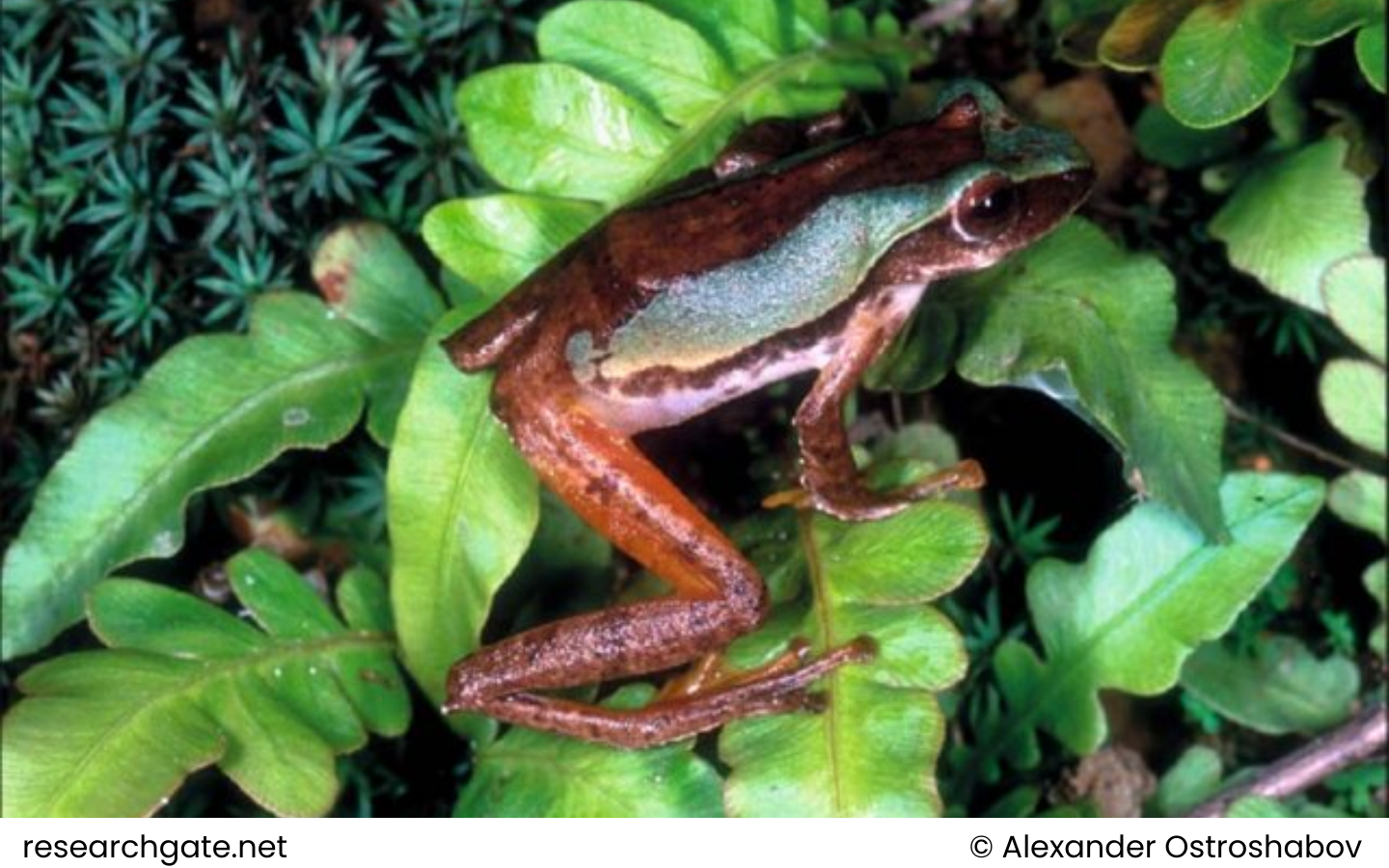
Science name: Rhacophorus hoanglienensis – Orlov, Lathrop, Murphy & Ho, 2001
Taxonomic: Animalia>> Chordata>> Amphibia>> Anura >> Rhacophoridae >> hoanglienensis
Species status: Endemic ; IUCN status: LC (Least Concern)
Description:
Physical Characteristics:
Rhacophorus hoanglienensis has a snout-vent length (SVL) of around 55.93 mm. The body is robust, with a flat dorsal surface and a rounded snout. Its back is typically chocolate brown or beige, with small black spots. A distinctive bright green stripe runs from between the eyes, splitting behind the shoulders and ending near the hips, which can change color to pale yellow. The frog’s belly is yellow, with the inner thighs and legs displaying bright red. Its webbed feet aid in arboreal movement, and its toes have prominent adhesive discs for gripping.
Distribution and habitat:
Altitude:
Rhacophorus hoanglienensis is found at elevations ranging from 600 to 1,900 meters above sea level (asl).
Range:
This species is native to northern Vietnam, particularly in the provinces of Lao Cai, Ha Giang, Tuyen Quang, and Vinh Phuc. There is a possibility that the species also occurs in southern Yunnan Province, China, as similar habitats and elevations exist there. The estimated extent of occurrence (EOO) is 28,023 km². Although it is widespread within its known range, its presence in adjacent areas remains uncertain and requires further surveys.
Habitat:
The species inhabits subtropical and tropical moist montane forests, where individuals have been observed on foliage about 2 meters above the ground. It is likely to breed in still water, such as marshes or pools, as do many other Rhacophorus species. The habitat throughout much of its range is undergoing degradation, particularly from agricultural expansion.
Behaviour and ecology:
Lifestyle:
This arboreal species lives near streams or waterfalls in moist tropical montane forests. It is primarily active during the night, particularly during the breeding season, when males call to attract females. Its diet consists of insects found in its habitat. The species breeds during the early rainy season, laying eggs in foam nests on trees above temporary pools or stagnant water sources. Tadpoles eventually fall into the water from the foam nests after hatching, continuing their development in aquatic environments.
Reproduction:
The breeding season typically occurs at the start of the rainy season. Eggs are deposited in foam nests on trees near water sources. The tadpoles remain in the nests, feeding on nutrients from the egg mass, before dropping into the water where they continue their development.
Conservation and status:
IUCN Red List Category and Criteria:
Rhacophorus hoanglienensis is listed as “Least Concern” on the IUCN Red List. Despite being in decline due to habitat degradation, its wide distribution and presumed large population justify its current status. The species was last assessed in 2017.
Threats:
The primary threat to Rhacophorus hoanglienensis is habitat loss caused by agricultural expansion and forest degradation. The species’ habitat is experiencing ongoing pressure from human activities, particularly deforestation for agriculture. As the species is dependent on forested environments and clean water sources for breeding, any further destruction of these habitats could negatively impact its populations.
Conservation Actions:
Currently, Rhacophorus hoanglienensis occurs within protected areas, such as the Hoang Lien National Park, which offers some protection from habitat destruction. However, continuous monitoring of its population and habitat is needed to prevent further declines. Conservation efforts should focus on habitat preservation and restoration, particularly in regions facing agricultural encroachment. Further research is also necessary to better understand its population dynamics, ecology, and breeding behavior.
Crocodile Trail – The Best Birding Trail in Cat Tien National Park
If you’re a birder or nature photographer planning a trip to Vietnam, few places offer [...]
Cong Troi Trail – Top 1 Dalat Plateau Birding Trail Experience
If you’re a birder or nature photographer planning a trip to Vietnam’s Central Highlands, the [...]
How to Identify the Greater Sand Plover, Tibetan Sand Plover and Siberian Sand Plover
Identification Differences within the Sand Plover Complex: The sand plover group, which was traditionally divided [...]
Highlights of Cat Tien National Park Reptiles and Amphibian Endemics
Spanning over 71,350 hectares of tropical forests, grasslands, and wetlands, Cat Tien National Park is [...]
Highlights of Cat Tien National Park Mammals in a World Biosphere Reserve
In addition to reptiles and birds, Cat Tien National Park is also rich in mammals, [...]
Kontum Plateau Endemic and Highlight bird
Kontum Plateau Endemic And Highlight Bird species like Chestnut-eared Laughingthrush and top birding routes while [...]